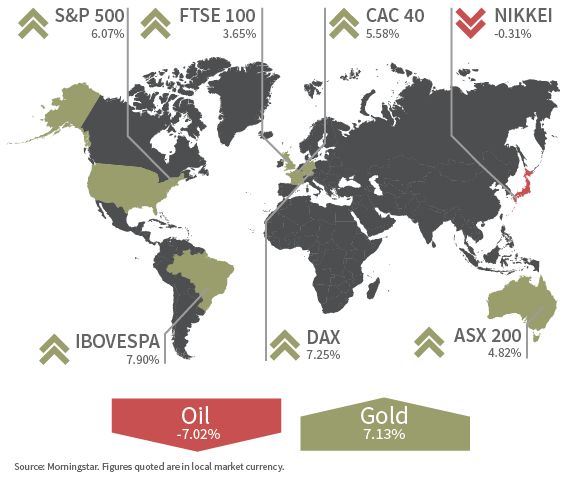Key markets at a glance – 1 January 2017 to 31 March 2017

United States of America
The US Federal Reserve (Fed) raised interest rates for the second time in three months at its March meeting to a target range of 0.75% to 1.0%.
It would appear to have reacted to a combination of strong employment data, rising inflation and consumer confidence, which hit its highest level since 2001. However, these are lagging indicators. More accurate leading indicators provide a balanced picture. Durable goods orders rose 5.0% on the year in February, the fastest level of growth since 2014. Whilst some improvement is clear, after adjusting for inflation, the metric is down 18% from the start of 2008, highlighting weak real wage growth over time. Industrial production has also improved modestly but has been held back by the strong US dollar. In reflection of the challenges facing the economy, the Atlanta Fed cut its own year on year GDP growth forecast to just 0.5% for the first quarter, seemingly at odds with the Fed’s optimistic view.
United Kingdom
Survey data has been relatively weak with the Purchasing Managers’ Index (PMI) Manufacturing Index falling to a four month low.
The reports cited cautious spending from consumers due to the weak pound and higher inflation against a backdrop of weak wage growth. In aggregate, the reports suggest that GDP growth will slow to 0.4% for the first quarter, down from 0.7%. For the three months to February, retail sales volumes contracted by 1.4%, the worst performance in seven years. However, exporters have been boosted by the currency as demonstrated by an improvement in industrial production. There has been a slowdown in the lending growth rate; although outstanding mortgages rose to a record £1.33tn, the annual rate of growth has fallen from 3.1% last July to 2.6% in January. Any further slowdown would have a negative impact on output. The savings ratio fell to an all-time low of 3.3% in the final quarter of 2016, suggesting that future growth in consumption may be limited.
Europe
Investors were relieved at the outcome of the Dutch elections as the extremist challenger, Geert Wilders, was defeated by the mainstream parties.
However, the trend towards populism remains strong across Europe due to public dissatisfaction towards immigration and weak economic growth. Nevertheless, the PMI Composite Index climbed to the highest level in six years, signalling an expected growth rate of 0.6% in the first quarter, reflecting an improvement in momentum. Whilst the report indicated a strong improvement in employment, considered to be the strongest for nearly a decade, this has not yet been confirmed by official data. As the PMI reports are survey based and data can be volatile from month to month, they do not always corroborate with the actual data. It was, however, a welcome development to see growth evident in France, Italy and Spain, not just in Germany.
Japan
Quarterly GDP growth rate was upgraded to 0.3% for the final quarter of 2016. This resulted from a modest upgrade to private consumption and exports.
Industrial production has been improving, boosted by yen weakness which has made Japanese products more attractive to overseas buyers. Despite unemployment at 3%, close to the lowest level in over 20 years, the domestic sector remains weak. Household spending remains in contraction and retail sales growth low. Intervention by the Bank of Japan has pushed the yield curve modestly higher with 10 year yields anchored just above 0%, helping to improve confidence in the equity market. Inflation has risen too, having turned positive in the fourth quarter of 2016. However, the move is more likely to reflect global factors and the sharp year on year increase in oil, rather than any structural increase in demand. It is unlikely to result in any change in monetary policy.
Far East
Over the quarter, economic data in China has been mixed. Industrial production and capital expenditure beat expectations, showing some signs of stability.
However, retail sales growth fell to the lowest in eleven years at 9.5%. Despite solid headline data and official forecasts of GDP growth of 6.5% for the calendar year, the China Beige Book, an independent survey of economic conditions in the country, highlighted deterioration in corporate cash flow and a rise in borrowing, suggesting signs of underlying weakness. Housing appears to have peaked, with the annual growth rate having declined for the last four months, down from 12.6% in November 2016. A sharp decline would likely be a negative sign for industrial commodities. Output in Australia rebounded in the fourth quarter following a fall in the previous period. Due to exposure to raw materials, the economy is heavily dependent on Chinese growth.
Emerging Markets
Emerging market equities have proved resilient despite the US increasing interest rates and showing commitment to higher rates over the course of the year.
These actions could have been expected to cause a stronger US dollar, undermining emerging market currencies and their economies in general, given high levels of US dollar debt outstanding. Fears remain over the protectionist agenda of the US under Trump which may threaten emerging market trade. However, with no firm policies yet announced, equity markets have been complacent so far. Commodity prices make a crucial difference to the outlook of different emerging markets. Falling oil prices have benefited India and China, for example, as they are not major producers and benefit from a lower cost of imports whilst the Russian economy has suffered. Brazil has now suffered eight consecutive quarters of negative GDP with the decline accelerating to -0.9% in the fourth quarter of 2016.

